

NASA finds 'significant' water on moon. Black hole 'bully' blasts. A powerful jet of particles from a "supermassive" black hole has been seen blasting a nearby galaxy, according to the US space agency (Nasa).
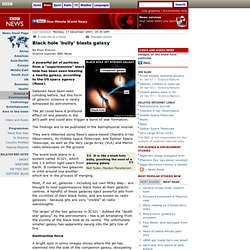
Galaxies have been seen colliding before, but this form of galactic violence is rarely witnessed by astronomers. Hell planet where rock falls as rain found. Plants 'thrive' on Moon ro. Smallest planet outside solar system found. Earth's Final Sunset Predicted. "Some say the world will end in fire, Some say in ice," wrote the poet Robert Frost.
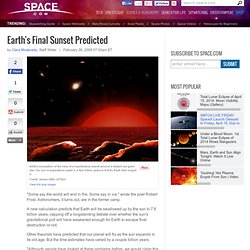
Astronomers, it turns out, are in the former camp. A new calculation predicts that Earth will be swallowed up by the sun in 7.6 billion years, capping off a longstanding debate over whether the sun's gravitational pull will have weakened enough for Earth to escape final destruction or not. The Milky Way is twice the size we thought it was - News and Eve.
20 February 2008 It took just a couple of hours using data available on the internet for University of Sydney scientists to discover that the Milky Way is twice as wide as previously thought.

Astrophysicist Professor Bryan Gaensler led a team that has found that our galaxy - a flattened spiral about 100,000 light years across - is 12,000 light years thick, not the 6,000 light years that had been previously thought. Proving not all science requires big, expensive apparatus, Professor Gaensler and colleagues, Dr Greg Madsen, Dr Shami Chatterjee and PhD student Ann Mao, downloaded data from the internet and analysed it in a spreadsheet. "We were tossing around ideas about the size of the Galaxy, and thought we had better check the standard numbers that everyone uses.
It took us just a few hours to calculate this for ourselves. The University of Sydney team's analysis differs from previous calculations because they were more discerning with their data selection. About Professor Bryan Gaensler: Scientists Find Solar System Like Ours. Google backs private Moon landing. Search giant Google is offering a $30m prize pot to private firms that land a robot rover on the Moon.
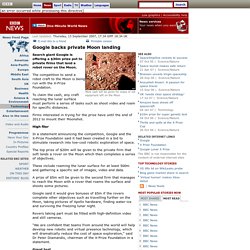
The competition to send a robot craft to the Moon is being run with the X-Prize Foundation. To claim the cash, any craft reaching the lunar surface must perform a series of tasks such as shoot video and roam for specific distances. Firms interested in trying for the prize have until the end of 2012 to mount their Moonshot. High flier In a statement announcing the competition, Google and the X-Prize Foundation said it had been created in a bid to stimulate research into low-cost robotic exploration of space. Water Vapor Seen 'Raining Down' on Young Star System. Do black holes really exist? Cookies on the New Scientist website close Our website uses cookies, which are small text files that are widely used in order to make websites work more effectively.

To continue using our website and consent to the use of cookies, click away from this box or click 'Close' Find out about our cookies and how to change them. Mars rover finds "puddles" on the planet's surfac. Cookies on the New Scientist website close Our website uses cookies, which are small text files that are widely used in order to make websites work more effectively.

To continue using our website and consent to the use of cookies, click away from this box or click 'Close' Find out about our cookies and how to change them Log in Your login is case sensitive. Water detected on distant planet. The atmosphere is evaporating under the heat from its star The planet, known as HD 209458b, is a Jupiter-like gas giant located 150 light-years from Earth in the constellation Pegasus. Scientists will publish the findings in the Astrophysical Journal. However, another research team reported in February that it was unable to find evidence of water in this planet's atmosphere. Water vapour (or steam) was expected to be present in atmospheres of most known extrasolar planets, even those that orbit more closely to their parent star than Mercury is to our Sun.
For the majority of exoplanets, their close proximity to their parent star has made detecting water and other compounds difficult. The identification reported here takes advantage of the fact that HD209458b, as seen from Earth, passes directly in front of its star every three-and-half days. As a planet passes in front of a star, its atmosphere blocks a different amount of starlight at different wavelengths. 'Cave entrances' spotted o. Scientists studying pictures from Nasa's Odyssey spacecraft have spotted what they think may be seven caves on the surface of Mars.
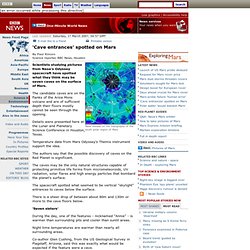
The candidate caves are on the flanks of the Arsia Mons volcano and are of sufficient depth their floors mostly cannot be seen through the opening. Details were presented here at the Lunar and Planetary Science Conference in Houston, Texas. Probe reveals seas on Saturn moon. The Cassini radar image (left) shows one of Titan's seas is larger than Lake Superior (right) Nasa's Cassini probe has found evidence for seas, probably filled with liquid hydrocarbons, at the high northern latitudes of Saturn's moon Titan.
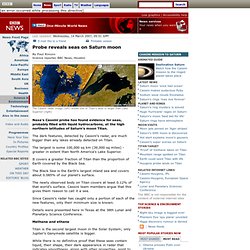
The dark features, detected by Cassini's radar, are much bigger than any lakes already detected on Titan. The largest is some 100,000 sq km (39,000 sq miles) - greater in extent than North America's Lake Superior. Hot start explains moon's geyse. The plumes of water that erupt from Saturn's icy satellite Enceladus can be traced back to a radioactive "meltdown" shortly after the moon formed.
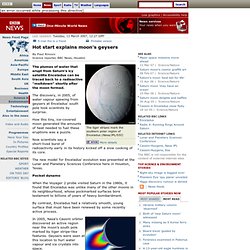
The discovery, in 2005, of water vapour spewing from geysers at Enceladus' south pole took scientists by surprise. How this tiny, ice-covered moon generated the amounts of heat needed to fuel these eruptions was a puzzle. Now scientists say a short-lived burst of radioactivity early in its history kicked off a slow cooking of its core. The new model for Enceladus' evolution was presented at the Lunar and Planetary Sciences Conference here in Houston, Texas.
Pocket dynamo When the Voyager 2 probe visited Saturn in the 1980s, it found that Enceladus was unlike many of the other moons in its neighbourhood, whose pockmarked surfaces bore testament to billions of years of heavy bombardment. By contrast, Enceladus had a relatively smooth, young surface that must have been renewed by some recently active process. Rapid decay Gas detection.